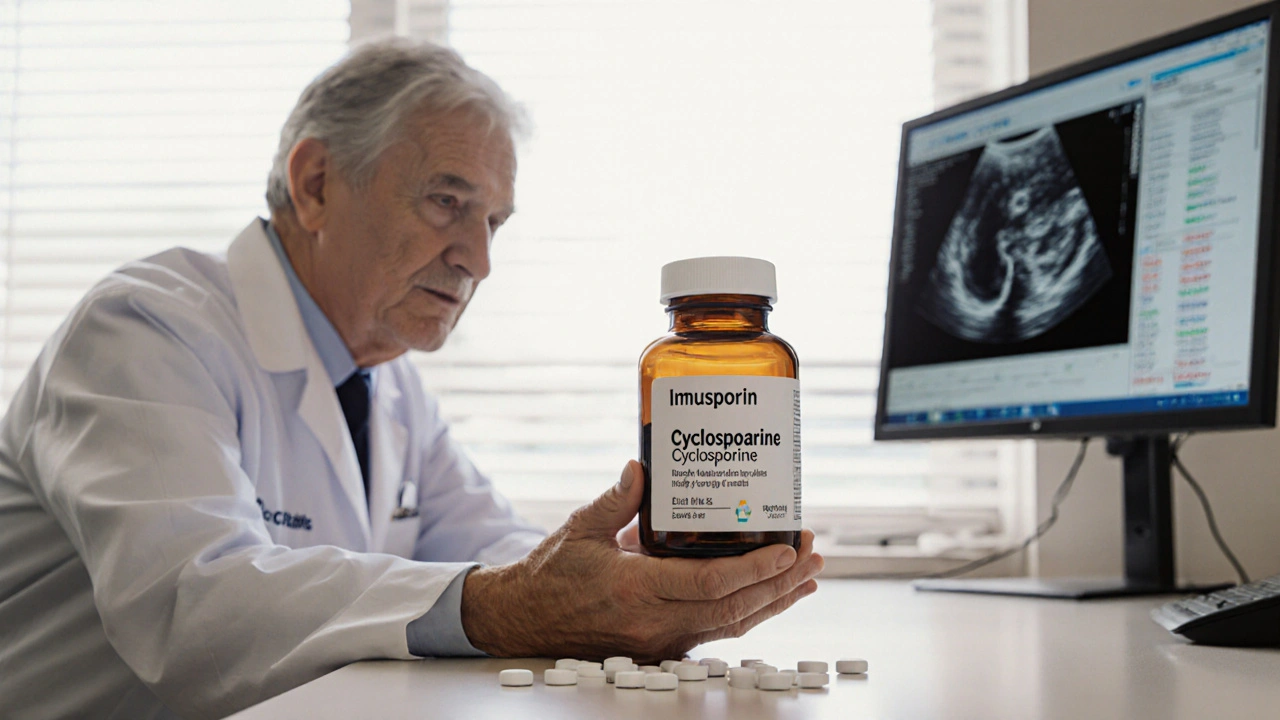Immunosuppressant Drug Selector
Select your clinical scenario to compare immunosuppressant options:
Quick Takeaways
- Cyclosporine (Imusporin) blocks T‑cell activation by inhibiting calcineurin.
- Tacrolimus is a more potent calcineurin inhibitor with a slightly different side‑effect profile.
- Mycophenolate mofetil targets nucleotide synthesis, making it a good steroid‑sparing option.
- Azathioprine and prednisone are older agents; they work but need careful monitoring.
- Choosing the right drug depends on the transplant type, kidney function, and individual tolerance.
What is Imusporin (Cyclosporine)?
When building an immunosuppression regimen, Imusporin is the brand name for cyclosporine, a calcineurin inhibitor that suppresses the immune system by preventing T‑cell activation. First approved in the early 1980s, cyclosporine has become a cornerstone for preventing organ rejection and treating severe autoimmune conditions such as psoriasis and rheumatoid arthritis.
How Cyclosporine Works
Cyclosporine binds to cyclophilin, forming a complex that blocks the enzyme calcineurin. Without calcineurin, the transcription factor NFAT stays inactive, and the cascade that leads to interleukin‑2 (IL‑2) production is halted. The result is a blunt‑force reduction in T‑cell proliferation.
Typical Uses and Dosage
Doctors prescribe cyclosporine for:
- Kidney, liver, and heart transplants - usually 3-5mg/kg/day split into two doses.
- Severe psoriasis - a starting dose of 2.5mg/kg/day.
- Rheumatoid arthritis unresponsive to other drugs - dosing similar to transplant protocols.
Blood levels are monitored closely; therapeutic trough concentrations usually sit between 100-400ng/mL, depending on the indication.

Key Benefits and Drawbacks
Cyclosporine is effective and has a long track record, but it comes with a handful of concerns:
- Nephrotoxicity: kidney function can decline, especially at higher levels.
- Hypertension and hyperlipidemia are common, requiring lifestyle tweaks or additional meds.
- Gum hyperplasia and hirsutism may affect appearance.
- Drug‑drug interactions are plentiful - especially with CYP3A4 inhibitors like ketoconazole.
Alternative Immunosuppressants
Below are the most frequently considered alternatives, each with its own mechanism and safety profile.
Tacrolimus is another calcineurin inhibitor, chemically distinct from cyclosporine and often marketed as Prograf. It is about 10‑fold more potent, meaning lower blood concentrations achieve the same immune suppression.
Mycophenolate mofetil is an antimetabolite that inhibits inosine monophosphate dehydrogenase, blocking guanine synthesis in lymphocytes. It’s popular for steroid‑sparing strategies.
Azathioprine is a purine analog that interferes with DNA synthesis, affecting rapidly dividing cells like T‑ and B‑lymphocytes. It’s older, inexpensive, but requires TPMT enzyme testing.
Prednisone is a corticosteroid that broadly suppresses inflammation and immune responses. Often used in the early post‑transplant period or as a bridge.
Sirolimus is an mTOR inhibitor that blocks cell‑cycle progression, offering a non‑calcineurin pathway for immunosuppression. It’s kidney‑friendly but can cause hyperlipidemia.
Everolimus is a derivative of sirolimus with similar mTOR inhibition, approved for kidney transplants and certain cancers. It shares sirolimus’s side‑effects while allowing once‑daily dosing.
Belatacept is a costimulation blocker that binds CD80/86, preventing T‑cell activation without affecting calcineurin. It’s used mainly in renal transplantation to avoid nephrotoxicity.
Side‑by‑Side Comparison
| Drug | Mechanism | Typical Indications | Common Monitoring | Main Side Effects |
|---|---|---|---|---|
| Cyclosporine (Imusporin) | Calcineurin inhibition | Kidney, liver, heart transplants; severe psoriasis | Blood trough levels, renal function, blood pressure | Nephrotoxicity, hypertension, gum hyperplasia |
| Tacrolimus | Calcineurin inhibition (more potent) | Kidney, liver transplants; atopic dermatitis | Blood trough levels, glucose, renal function | Nephrotoxicity, diabetes, neurotoxicity |
| Mycophenolate mofetil | Inosine monophosphate dehydrogenase inhibition | Kidney & heart transplants; lupus nephritis | Complete blood count, liver enzymes | GI upset, leukopenia, infection risk |
| Azathioprine | Purine analog - DNA synthesis blockade | Kidney transplants; inflammatory bowel disease | TPMT activity, CBC, liver enzymes | Bone marrow suppression, hepatotoxicity |
| Prednisone | Corticosteroid - broad immune suppression | Early post‑transplant, autoimmune flare‑ups | Blood glucose, bone density, blood pressure | Weight gain, osteoporosis, mood swings |
| Sirolimus | mTOR inhibition | Kidney transplants (calcineurin‑sparing) | Lipid profile, renal function, wound healing | Hyperlipidemia, delayed wound healing, anemia |
| Everolimus | mTOR inhibition (once‑daily) | Kidney transplants; certain cancers | Lipid profile, renal function, infection markers | Similar to sirolimus - lipids, infections |
| Belatacept | Costimulation blockade (CD80/86) | Renal transplantation (calcineurin‑free) | EBV serology, renal function, infection surveillance | Post‑transplant lymphoproliferative disorder, infusion reactions |
When to Choose Cyclosporine Over Alternatives
If you need rapid, strong suppression and have reliable access to blood‑level testing, cyclosporine remains a solid pick. It shines in:
- Patients with a history of tacrolimus‑induced diabetes.
- Transplant protocols that rely on tried‑and‑true dosing regimens.
- Situations where cost is a major factor - generic cyclosporine is cheaper than many newer agents.
When an Alternative Might Suit Better
Consider switching if you encounter any of the following:
- Persistent kidney function decline despite optimal dosing - sirolimus, everolimus, or belatacept can spare the kidneys.
- New‑onset diabetes after transplant - tacrolimus has a higher diabetogenic risk; mycophenolate may be safer.
- Intolerable cosmetic side effects like gum overgrowth - mycophenolate or azathioprine have fewer oral issues.
- Need for steroid tapering - combining mycophenolate with low‑dose prednisone often works well.
Practical Checklist for Switching or Initiating Therapy
- Confirm the primary clinical goal (prevent rejection, control autoimmunity, minimize side‑effects).
- Review baseline labs: creatinine, liver enzymes, CBC, fasting glucose, lipid panel.
- Check drug‑interaction list - especially CYP3A4 modulators for cyclosporine and tacrolimus.
- Select a target therapeutic window based on the chosen agent (e.g., tacrolimus trough 5-15ng/mL).
- Set monitoring frequency: weekly for the first month, then monthly if stable.
- Educate the patient on signs of toxicity - new hypertension, swelling, mouth sores, or unusual bruising.
- Document the plan in the electronic health record, noting the rationale for the chosen regimen.
Common Pitfalls and How to Avoid Them
Even experienced clinicians can slip into traps. Here are three to watch:
- Assuming therapeutic equivalence: Tacrolimus is more potent; you cannot simply replace cyclosporine dose‑for‑dose.
- Ignoring genetic testing: TPMT deficiency can make azathioprine dangerously toxic.
- Over‑relying on symptom relief: Some side effects (like rising creatinine) are silent; regular labs are non‑negotiable.
Bottom Line for Clinicians and Patients
Cyclosporine (Imusporin) remains a workhorse, especially when cost, familiarity, and rapid effect matter. Yet the therapeutic landscape has expanded - tacrolimus, mycophenolate, and mTOR inhibitors give you tools to tailor therapy, protect kidneys, and reduce metabolic complications.
Choosing the right agent is less about “best overall” and more about matching drug characteristics to the individual’s health profile, transplant type, and lifestyle.
Frequently Asked Questions
Can I take cyclosporine and tacrolimus together?
No. Both drugs act on the same calcineurin pathway and add up their nephrotoxic risk. If a patient needs extra suppression, clinicians usually add mycophenolate or a low‑dose steroid instead.
Why does cyclosporine cause high blood pressure?
Calcineurin inhibition leads to sodium retention and vasoconstriction, which pushes the blood pressure up. Monitoring and adding an ACE inhibitor early can keep it under control.
Is mycophenolate safer for the kidneys than cyclosporine?
Yes. Mycophenolate does not hit the kidneys directly, so patients with borderline renal function often tolerate it better. However, it can cause bone‑marrow suppression, so regular blood counts are essential.
What lab tests are required for azathioprine?
First, test TPMT enzyme activity to gauge dose safety. Then, monitor CBC and liver enzymes every 1-2 weeks during the start‑up phase, followed by monthly checks once stable.
Can belatacept replace cyclosporine in heart transplants?
Belatacept is FDA‑approved mainly for kidney transplants; its data in heart transplants are limited. Most centers still rely on calcineurin inhibitors for hearts, adding belatacept only in clinical trials.


While the comparative table offers a concise overview, it neglects to address the pharmacoeconomic implications of prolonged cyclosporine therapy, which remain a pivotal concern for both clinicians and healthcare systems. The omission of cost-benefit analyses, particularly in the context of generic availability versus newer agents, undermines the utility of the presented data. Moreover, the discussion fails to delineate the nuanced management strategies required for cyclosporine‑induced hypertension, a frequent and clinically significant adverse effect. A more rigorous appraisal would necessitate integrating renal function trajectories alongside therapeutic drug monitoring protocols. In sum, the article requires a deeper, more systematic exploration of these critical variables to serve its intended audience adequately.